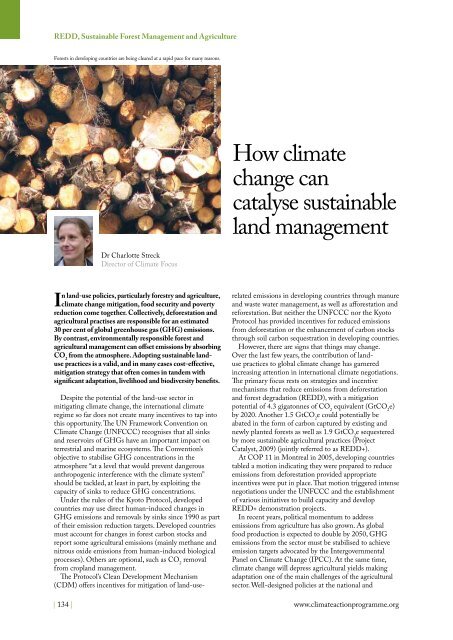Climate Action 2010-2011
You also want an ePaper? Increase the reach of your titles
YUMPU automatically turns print PDFs into web optimized ePapers that Google loves.
Redd, Sustainable Forest Management and Agriculture<br />
Forests in developing countries are being cleared at a rapid pace for many reasons.<br />
© Creative commons/flickr/mïK<br />
How climate<br />
change can<br />
catalyse sustainable<br />
land management<br />
Dr Charlotte Streck<br />
Director of <strong>Climate</strong> Focus<br />
In land-use policies, particularly forestry and agriculture,<br />
climate change mitigation, food security and poverty<br />
reduction come together. Collectively, deforestation and<br />
agricultural practises are responsible for an estimated<br />
30 per cent of global greenhouse gas (GHG) emissions.<br />
By contrast, environmentally responsible forest and<br />
agricultural management can offset emissions by absorbing<br />
CO 2<br />
from the atmosphere. Adopting sustainable landuse<br />
practices is a valid, and in many cases cost-effective,<br />
mitigation strategy that often comes in tandem with<br />
significant adaptation, livelihood and biodiversity benefits.<br />
| 134 |<br />
Despite the potential of the land-use sector in<br />
mitigating climate change, the international climate<br />
regime so far does not create many incentives to tap into<br />
this opportunity. The UN Framework Convention on<br />
<strong>Climate</strong> Change (UNFCCC) recognises that all sinks<br />
and reservoirs of GHGs have an important impact on<br />
terrestrial and marine ecosystems. The Convention’s<br />
objective to stabilise GHG concentrations in the<br />
atmosphere “at a level that would prevent dangerous<br />
anthropogenic interference with the climate system”<br />
should be tackled, at least in part, by exploiting the<br />
capacity of sinks to reduce GHG concentrations.<br />
Under the rules of the Kyoto Protocol, developed<br />
countries may use direct human-induced changes in<br />
GHG emissions and removals by sinks since 1990 as part<br />
of their emission reduction targets. Developed countries<br />
must account for changes in forest carbon stocks and<br />
report some agricultural emissions (mainly methane and<br />
nitrous oxide emissions from human-induced biological<br />
processes). Others are optional, such as CO 2<br />
removal<br />
from cropland management.<br />
The Protocol’s Clean Development Mechanism<br />
(CDM) offers incentives for mitigation of land-userelated<br />
emissions in developing countries through manure<br />
and waste water management, as well as afforestation and<br />
reforestation. But neither the UNFCCC nor the Kyoto<br />
Protocol has provided incentives for reduced emissions<br />
from deforestation or the enhancement of carbon stocks<br />
through soil carbon sequestration in developing countries.<br />
However, there are signs that things may change.<br />
Over the last few years, the contribution of landuse<br />
practices to global climate change has garnered<br />
increasing attention in international climate negotiations.<br />
The primary focus rests on strategies and incentive<br />
mechanisms that reduce emissions from deforestation<br />
and forest degradation (REDD), with a mitigation<br />
potential of 4.3 gigatonnes of CO 2<br />
equivalent (GtCO 2<br />
e)<br />
by 2020. Another 1.5 GtCO 2<br />
e could potentially be<br />
abated in the form of carbon captured by existing and<br />
newly planted forests as well as 1.9 GtCO 2<br />
e sequestered<br />
by more sustainable agricultural practices (Project<br />
Catalyst, 2009) (jointly referred to as REDD+).<br />
At COP 11 in Montreal in 2005, developing countries<br />
tabled a motion indicating they were prepared to reduce<br />
emissions from deforestation provided appropriate<br />
incentives were put in place. That motion triggered intense<br />
negotiations under the UNFCCC and the establishment<br />
of various initiatives to build capacity and develop<br />
REDD+ demonstration projects.<br />
In recent years, political momentum to address<br />
emissions from agriculture has also grown. As global<br />
food production is expected to double by 2050, GHG<br />
emissions from the sector must be stabilised to achieve<br />
emission targets advocated by the Intergovernmental<br />
Panel on <strong>Climate</strong> Change (IPCC). At the same time,<br />
climate change will depress agricultural yields making<br />
adaptation one of the main challenges of the agricultural<br />
sector. Well-designed policies at the national and<br />
www.climateactionprogramme.org












